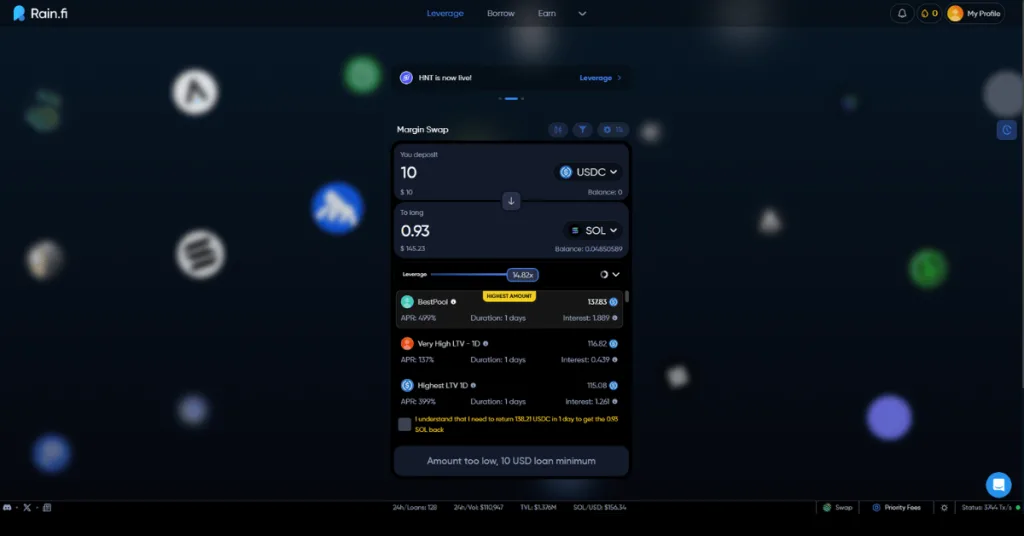Rain.fi is an innovative peer-to-peer (P2P) lending protocol built on the Solana blockchain, designed to make decentralized lending more flexible, accessible, and efficient.

Instead of relying on rigid pool-based lending systems, Rain.fi empowers users to create their own customized loan pools, defining specific terms such as interest rates, loan durations, and collateral conditions.
This approach transforms DeFi lending into a more personalized and dynamic marketplace, where anyone can become a lender or borrower under transparent, programmable conditions.
By leveraging Solana’s high throughput and low fees, Rain.fi offers an ultra-fast and low-cost experience for borrowing and lending both tokens and NFTs, giving users liquidity without needing to sell their digital assets.
Introduction to Rain.fi
At its core, Rain.fi enables users to lend and borrow cryptocurrencies or NFTs directly, without traditional intermediaries.
Unlike conventional DeFi platforms that operate shared liquidity pools with standardized terms, Rain.fi allows participants to create or join fully customizable loan offers.
Lenders can define their preferred conditions, while borrowers can choose loans that match their needs.
This model is ideal for:
- NFT holders who want liquidity without selling their assets.
- Traders seeking flexible leverage.
- Investors looking to earn sustainable yield with predictable terms.
Since launch, Rain.fi has integrated with major Solana protocols and continues to expand through new modules such as NFT mortgages, non-liquidating leveraged trading, and liquid staking-as-a-service.
Key Features
1. NFT-Backed Loans
Rain.fi is one of the first Solana protocols to support NFT-backed lending.
Users can deposit NFTs or tokens (like SOL, USDC, mSOL, BONK, or SAMO) as collateral to access instant liquidity.
This system enables users to borrow funds without selling their valuable assets — a major advantage during volatile market conditions.
Rain.fi even introduced a Buy Now, Pay Later (BNPL) system for NFTs, effectively creating digital asset mortgages.
Buyers can purchase high-value NFTs by paying a fraction upfront and financing the rest through a loan.
2. No Price-Based Liquidations
Unlike most lending protocols that automatically liquidate positions when prices fall, Rain.fi uses a time-based loan expiration model.
This means loans are repaid or expire at pre-set times rather than being liquidated based on market volatility — providing stability and predictability for users.
3. Custom Loan Pools
Users can create custom lending pools, defining interest rates, loan-to-value ratios (LTVs), and durations.
Borrowers can browse these offers and select the ones that fit their goals, creating a decentralized marketplace for credit with total transparency.
4. Liquid Staking and “Liquid as a Service”
Rain.fi also features a liquid staking module, allowing users to stake tokens (like JUP or COLLAT) and still maintain liquidity.
Projects on Solana can integrate Rain.fi’s staking model directly through its Liquid as a Service feature, enabling native staking options across ecosystems.
5. Non-Liquidating Leveraged Trading
The protocol also supports leveraged trading without liquidation risk.
Instead of liquidating positions when market prices move against traders, Rain.fi locks collateral until loan expiration, enabling safer leverage exposure with defined time limits.
How Rain.fi Works
The lending process is designed to be simple yet powerful.
- Lenders create loan pools and define key parameters:
- Interest rate (APR)
- Duration
- Loan-to-value (LTV) ratio
- Borrowers browse available pools, deposit collateral (tokens or NFTs), and take loans under the offered terms.
- All interactions are handled by smart contracts, ensuring transparency and automation.
- Oracles like Pyth Network provide accurate real-time pricing data.
- Integrations with Jupiter Exchange allow efficient token swaps within the ecosystem.
- Once a loan expires, borrowers repay principal + interest, or lenders reclaim collateral if the borrower defaults.
This creates a self-sustaining lending marketplace where credit and liquidity circulate freely across Solana.
Advantages and Benefits
Rain.fi’s design introduces several key benefits for users:
- No forced liquidations: Loans are time-based rather than price-based, protecting users from market crashes.
- Customizable strategies: Lenders and borrowers set their own rules.
- Low costs: Built on Solana, with transaction fees close to zero.
- NFT liquidity: Users unlock capital from non-fungible assets.
- Passive yields: Lenders earn interest, staking rewards, and partner tokens.
The protocol is audited by Halborn Security and has integrated with multiple DeFi and RWA projects — making it one of the most interconnected platforms in the Solana ecosystem.
Integrations and Ecosystem
Rain.fi collaborates with major Solana projects to expand its functionality:
- Jupiter Exchange: Provides deep liquidity for token swaps.
- Pyth Network and Switchboard: Deliver real-time pricing data.
- Oro Gold: Enables collateralization of tokenized gold assets.
- Zirodelta: Integrates yield streams from perpetual funding markets.
- RECC Finance: Allows real-estate crowdfunding and RWA-backed loans.
Through these integrations, Rain.fi supports tokenized assets (RWAs), liquid staking tokens, and AI-driven financial agents — positioning itself as a liquidity hub for the entire Solana network.
Future Outlook
Rain.fi is rapidly expanding its ecosystem with new features such as:
- A universal liquid staking module for all tokens.
- The RECC Growth Initiative, connecting RWA-based liquidity to DeFi.
- Expanded integration with DeFi aggregators and Solana-native projects.
With over $20 million in COLLAT staked and growing participation, Rain.fi is well positioned to become a cornerstone of decentralized credit markets on Solana.
While smart contract and market risks remain inherent to any DeFi platform, Rain.fi’s audit record, modular architecture, and non-liquidation model make it one of the most secure and forward-thinking projects on Solana today.
How to Farm the Rain.fi Airdrop

Rain.fi’s airdrop system is based on its Droplets points program, designed to reward users for interacting with the protocol.
Droplets are distributed automatically for every action that contributes to ecosystem activity — such as lending, borrowing, staking, or leveraging.
They function as a loyalty and engagement metric, and are widely expected to play a role in a future airdrop.
Here’s how to farm effectively:
1. Supply and Borrow
- Deposit supported tokens like USDC, SOL, or JUP into lending pools.
- Create or join custom pools with fixed yields.
- Borrow tokens or stablecoins using your deposits as collateral.
- You’ll earn Droplets both as a lender and borrower.
You can also borrow against NFTs, using them as collateral to receive liquidity without selling them.
2. Liquid Staking and Integrations
- Use the liquid staking module to stake tokens such as JUP and still retain liquidity.
- Earn staking rewards plus Droplets points at the same time.
- Combine this with Jupiter Exchange integrations to move assets seamlessly between protocols — boosting your farming efficiency.
3. Quests and Partnerships
- Participate in Galxe quests to collect additional NFTs, loyalty badges, and bonus points.
- Projects like Housecoin and RECC Finance allow you to earn Droplets by supplying liquidity or using their tokens as collateral.
- Community speculation suggests owning Bold Badger NFTs might enhance airdrop allocation
Rain.fi is a protocol that truly contributes to Solana’s growth.
Its farming system is simple, transparent, and accessible, making it a perfect choice for both beginners and experienced users in the network.
Even if you’re not focused on the airdrop itself, interacting with Rain.fi can help strengthen your activity footprint within the Solana ecosystem — a key advantage for future ecosystem-wide rewards and campaigns.
🔗Links
Rain.fi: Official Website
Rain.fi Documentation: Docs
Disclaimer
This is not financial advice. If you decide to interact with the mentioned protocols, you do so at your own risk. Airdrop Guild is not responsible for any potential losses resulting from participation. Always do your own research before engaging with blockchain-based projects.